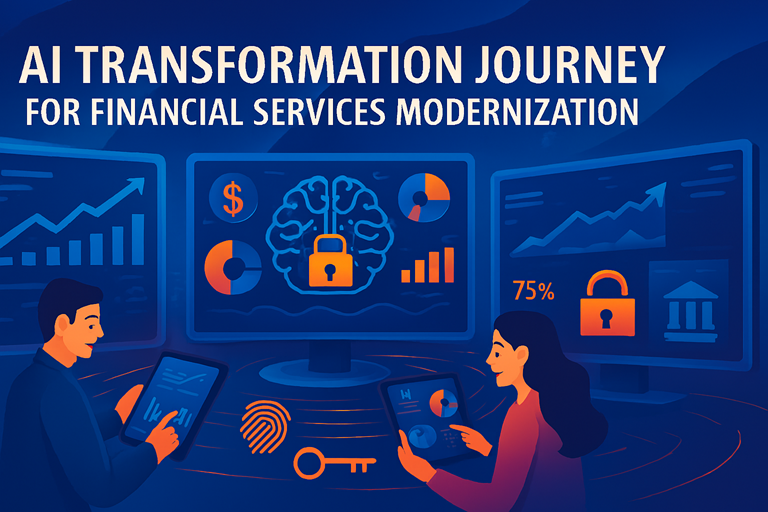
Status: Final Blueprint
Author: Shahab Al Yamin Chawdhury
Organization: Principal Architect & Consultant Group
Research Date: February 23 1, 2022
Location: Dhaka, Bangladesh Version: 1.0
Executive Summary
This blueprint provides a data-driven, actionable framework for financial services C-suite executives to navigate the AI-driven modernization imperative. Financial institutions face an “Experience-Efficiency Squeeze,” pressured by fintech challengers and the digital experience standards set by tech giants. Compounding this is a “Modernization Debt Spiral,” with 60-80% of tech budgets consumed by legacy system maintenance, stifling innovation. AI is the foundational enabler of a new, competitive operating model. This document details the core AI arsenal (Predictive AI, NLP, GenAI, RPA), a four-phase transformation canvas, an AI Maturity Index for benchmarking, and a robust framework for governance and ROI. The AI in Finance market is projected to reach up to $340 billion by 2030, making this transformation a critical driver of future profitability and market leadership.
Part I: The Unavoidable Modernization Imperative
- Convergence of Market Forces: The sector is pressured by escalating customer expectations for seamless, real-time digital experiences, the onslaught of hyper-efficient fintech and non-bank competitors, and macroeconomic volatility.
- The Legacy Burden: A significant portion of IT spending (60-80%) is allocated to maintaining outdated legacy systems, creating a “Modernization Debt Spiral” that prevents investment in innovation. This has led to an exponential increase in organizational complicatedness, hindering agility.
- The Regulatory Horizon: The intensifying regulatory landscape, with penalties for non-compliance reaching $250 billion over the past decade, is a catalyst for modernization. Leading firms are using AI to transform compliance from a cost center into a competitive moat.
Part II: The AI Arsenal: Core Technologies & Applications
- Predictive AI & Machine Learning (ML): Enables a shift from a reactive “detect and repair” model to a proactive “predict and prevent” framework. Key applications include advanced credit scoring, dynamic fraud detection, and algorithmic trading.
- Natural Language Processing (NLP): Unlocks value from unstructured data (text, voice). Powers intelligent customer service, real-time market sentiment analysis, and automated compliance monitoring. JPMorgan’s COIN platform saves 360,000 work-hours annually using NLP.
- Generative & Agentic AI (GenAI): The new frontier for creating original content (text, code, synthetic data) and executing complex, multi-step tasks autonomously. Applications include hyper-personalization, accelerated legacy code modernization, and autonomous workflows managed by multi-agent systems.
- Intelligent Process Automation (RPA): A foundational technology for automating high-volume, repetitive, rule-based tasks in back-office functions, customer onboarding (KYC/AML), and regulatory reporting.
Part III: The Transformation Canvas: A Phased Blueprint
A successful AI transformation is a multi-year journey executed in four distinct phases:
- Phase 1: Foundational Strategy & Vision Setting (Months 1-6): Establish a C-suite-driven vision, conduct a baseline maturity assessment, define the initial governance framework, and identify 2-3 high-impact pilot projects.
- Phase 2: Pilot Programs & Capability Building (Months 7-18): Execute pilot projects to deliver measurable value, begin building the core cloud and data architecture, and establish a formal AI Center of Excellence (CoE).
- Phase 3: Scaling & Industrialization of AI (Months 19-36): Scale successful AI solutions across the enterprise, transform entire business domains end-to-end, and evolve to a more federated “hub-and-spoke” operating model.
- Phase 4: Enterprise-Wide AI-Native Operations (Months 37+): Become a true “AI-first” institution where AI is embedded in the culture and all operations. Deploy autonomous agentic workflows and monetize proprietary AI capabilities.
Part IV: The AI Maturity Trajectory & Benchmarking
Progress is measured against an AI Maturity Index based on four critical pillars, benchmarked against industry leaders like JPMorgan Chase and Goldman Sachs.
- Talent (45% Weighting): The ability to attract, develop, and retain specialized AI talent.
- Innovation (30% Weighting): Capacity for R&D, reflected in patents, ventures, and open-source contributions.
- Leadership (15% Weighting): Visible and credible C-suite championship of the AI transformation.
- Transparency (10% Weighting): Commitment to responsible and ethical AI deployment.
An AI Center of Excellence (CoE) is the organizational engine driving this journey, initially operating under a centralized model to build critical mass before evolving to a more federated structure.
Part V: Governance and Economics
- Responsible AI Framework: Trust is paramount. This requires a focus on mitigating algorithmic bias, ensuring transparency through Explainable AI (XAI), and protecting data privacy. Advanced techniques like federated learning are key to preserving privacy while training models.
- The Economic Case: The AI in Finance market is projected to grow to between $190B and $340B by 2030. Documented ROI is significant:
- Mastercard: 300% improvement in fraud detection rates.
- Bank of America: 17% decrease in call center load via its “Erica” assistant.
- Revenue: 70% of firms attribute a >5% revenue lift to AI.
Part VI: The Next Frontier: Future-Ready Strategies
To maintain a competitive edge, institutions must prepare for the next wave of technological disruption:
- Tokenization and Digital Assets: The digitization of assets via blockchain represents a fundamental re-architecting of financial infrastructure, enabling instant, global settlement and fractional ownership of illiquid assets.
- Federated Learning: A collaborative AI model where institutions can jointly train more powerful models (e.g., for AML) without sharing sensitive raw data, overcoming privacy barriers.
- Quantum Computing: A long-term technological leap with the potential to solve currently intractable problems in portfolio optimization and risk modeling, but which also poses a threat to current encryption standards.
Strategic Recommendations
- Champion a C-Suite-Led, Business-First AI Vision.
- Adopt a Phased, Domain-Based Transformation Strategy.
- Invest Aggressively in a Modern Data and Technology Stack.
- Build a World-Class Talent and Governance Ecosystem.
- Benchmark Relentlessly and Foster an AI-Native Culture.